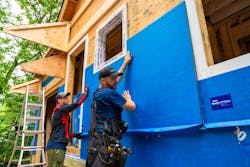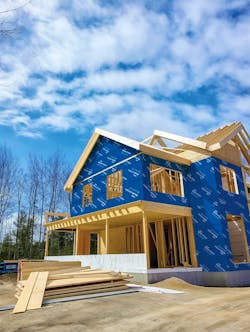Debunking Myths About Continuous Insulation: What Every Builder Should Know
1. Insulating wall cavities is enough to stop thermal bridging.
Some contractors believe that cavity insulation alone is sufficient, overlooking the significant energy loss caused by thermal bridging—the transfer of heat through framing materials. This oversight can compromise the overall thermal performance of a building.
Thermal imaging illustrates the problem vividly: heat escapes through studs, creating inefficiencies that could easily be addressed with CI. For example, a wall built with 2x4 framing and an additional R-5 CI is approximately 20% more thermally efficient than a wall with only 2x6 framing.
"Continuous insulation minimizes heat loss by providing a seamless thermal barrier across the wall," says Liang Gwee, Ph.D., Henry’s innovation and emerging technologies manager. "This not only reduces energy waste but also contributes to a more comfortable home."
2. CI complicates the construction process.
Many builders shy away from CI, assuming it adds unnecessary complexity to the construction process. However, modern CI products are designed with efficiency in mind. Expanded polystyrene (EPS) and graphite-enhanced EPS (GPS), for instance, combine high R-values with superior water resistance. There are also CI panels with integrated WRBs, eliminating the need for separate moisture barriers.
"By integrating thermal and water-resistive barriers, products like Henry Blueskin VPTech simplify installation," Gwee explains. "This approach streamlines the process, reducing time and labor while improving overall performance."
3. CI isn’t cost-effective.
The perception of CI as an added expense rather than a valuable investment can deter some contractors. However, homeowners increasingly prioritize energy efficiency, favoring homes that lower utility bills and offer enhanced comfort.
"Continuous insulation offers long-term value by improving indoor comfort and reducing energy costs," Gwee says. "It’s an investment that not only benefits the homeowner but also gives builders a competitive edge in the market."
4. CI doesn’t impact indoor air quality.
An airtight building envelope is key to healthier indoor air. By reducing air leakage, CI minimizes the infiltration of allergens, pollutants, and moisture, which can compromise air quality.
Additionally, CI helps maintain the sheathing’s temperature above the dew point, reducing the risk of mold and mildew. "It’s like wearing a winter coat for your building," Gwee notes. "This protection not only enhances energy efficiency but also promotes a healthier indoor environment."
5. CI makes code compliance harder.
On the contrary, CI simplifies compliance with evolving building codes. It provides flexibility for builders to achieve energy performance goals through a performance-based approach rather than rigid prescriptive measures.
"For example, CI allows builders to compensate for larger windows by increasing insulation elsewhere," Gwee explains. "As codes become more stringent, CI ensures homes are not just compliant but also future-proof."
Continuous Insulation: A Win-Win for Builders and Homeowners
As building codes demand higher energy efficiency, continuous insulation provides builders with a practical, cost-effective solution that enhances performance, simplifies installation, and meets modern standards. By embracing CI, contractors can deliver homes that are not only code-compliant but also better-performing and more comfortable for homeowners.
Henry’s Blueskin VPTech goes even further, integrating insulation, water-resistive barriers, and seam sealing into one panel. This innovation reduces installation time by up to 30%, helping builders meet energy codes with ease while improving overall efficiency.


